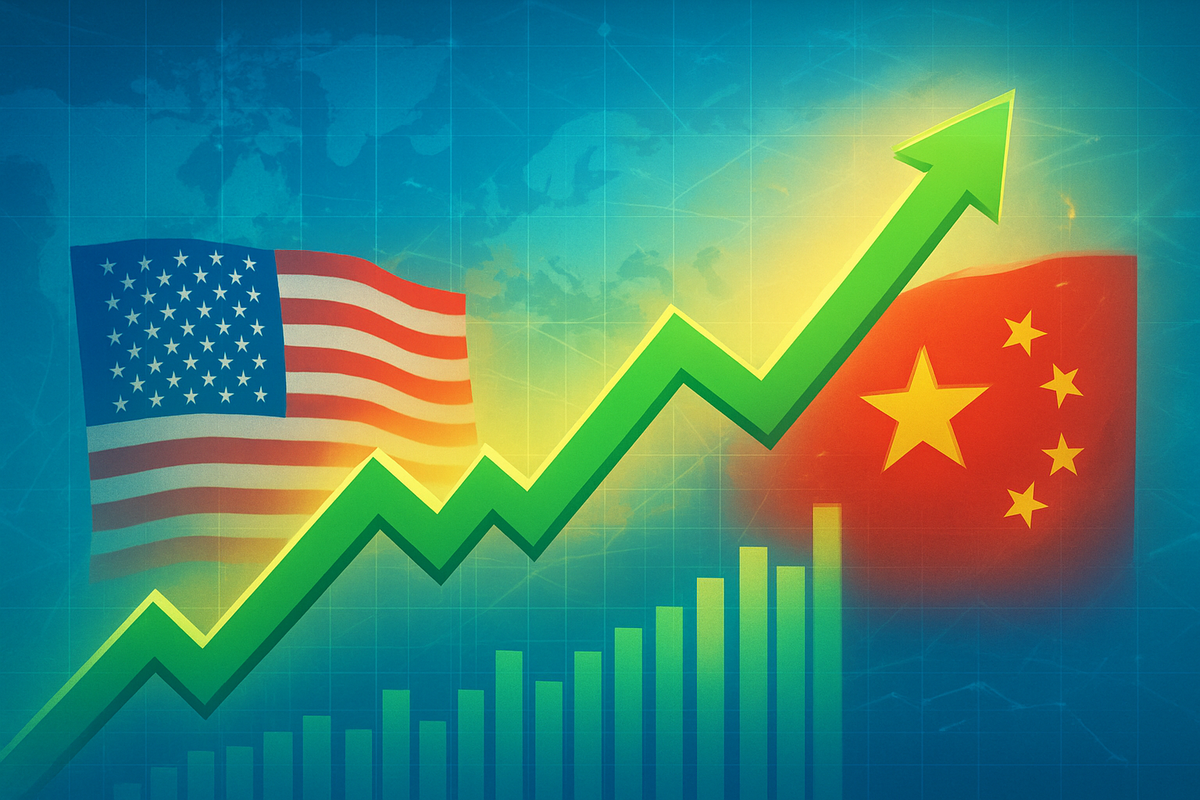
New York, NY – October 27, 2025 – A palpable wave of optimism regarding a potential breakthrough in US-China trade relations has sent global stock markets soaring, pushing major American indexes to unprecedented record highs. Investors are eagerly anticipating a "preliminary consensus" on a new trade deal, which has ignited a "risk-on" sentiment across financial markets, diverting capital from traditional safe havens into equities. This surge reflects a renewed hope for stability and growth in the world's two largest economies, signaling a potential end to a period of protracted trade tensions.
The market's enthusiastic response comes just days before a highly anticipated meeting between US President Donald Trump and Chinese President Xi Jinping, scheduled for October 30th in South Korea. The prospect of a comprehensive agreement has instilled confidence, suggesting that a significant impediment to global economic expansion could soon be resolved, paving the way for sustained market momentum.
A Framework for Peace: Details Emerge on Preliminary Trade Consensus
The recent market euphoria stems from two days of intensive, high-level trade discussions concluded in Malaysia, where top negotiators from both nations expressed strong optimism. U.S. Treasury Secretary Scott Bessent confirmed that a "very successful framework" has been established for the upcoming presidential meeting. This framework addresses several critical points that have been at the heart of the trade dispute.
Crucially, the threat of additional 100% tariffs on Chinese goods, previously floated by President Trump, is now "effectively off the table," providing much-needed relief and certainty for businesses. In a significant win for American agriculture, China is expected to resume substantial purchases of US agricultural products, particularly soybeans. Furthermore, China has reportedly agreed to delay or defer expanded export controls on rare earth minerals for approximately a year, a move that eases concerns over critical supply chains given China's dominant position in rare earth production. Beyond these key areas, the preliminary consensus also touches upon export controls, efforts to combat fentanyl trafficking, shipping levies, and even a "final deal" regarding the sale of the social media application TikTok in the US. President Trump himself has expressed confidence, stating his expectation for a "good deal with China."
These breakthroughs are the culmination of a series of high-level meetings and technical discussions that have unfolded throughout late 2024 and early to mid-2025. Negotiators have crisscrossed the globe, holding talks in Geneva, Washington, London, and Kuala Lumpur, gradually building the foundation for the current framework. The consistent dialogue, despite earlier setbacks, has ultimately led to this moment of cautious optimism. The immediate market reaction has been nothing short of spectacular. The Dow Jones Industrial Average (DJIA) (NYSEARCA: DIA) hit a record high of 47,207.12 on Friday, October 24, 2025, and continued its ascent to approximately 47,457.50 on Monday, October 27. Similarly, the S&P 500 (NYSEARCA: SPY) closed at a record 6,791.69 on Friday, further advancing to about 6,853.48 on Monday, reaching an all-time high of 6861.62. The tech-heavy Nasdaq Composite (NASDAQ: QQQ) also surged, reaching 23,204.87 on Friday and climbing to roughly 23,551.70 on Monday, setting new record highs. This broad-based rally underscores the market's belief that a significant de-escalation of trade tensions will unlock further economic potential.
Corporate Fortunes Shift: Winners and Losers Emerge
The anticipated US-China trade deal is poised to redraw the landscape for numerous public companies, creating clear winners and potential losers. Sectors most sensitive to trade relations, such as technology, retail, and social media, are experiencing significant tailwinds. Companies with substantial exposure to the Chinese consumer market or those heavily reliant on global supply chains are likely to see immediate benefits from reduced tariffs and increased stability.
Agricultural giants and food processing companies stand to gain immensely from China's expected resumption of large-scale US agricultural purchases, particularly soybeans. This could provide a much-needed boost to the bottom lines of companies like Archer-Daniels-Midland (NYSE: ADM) and Bunge Limited (NYSE: BG), which have been impacted by the previous trade disruptions. Technology companies, including chipmakers and software providers, are also breathing a sigh of relief. The reduction in trade uncertainty could lead to increased demand and smoother operations for industry titans such as Apple (NASDAQ: AAPL), which has a significant manufacturing presence and consumer base in China, and semiconductor firms like Qualcomm (NASDAQ: QCOM) and Intel (NASDAQ: INTC).
Conversely, some sectors face headwinds. Rare earth miners, for instance, saw their shares decline following the news that China would delay or defer its expanded export controls on rare earth minerals. Companies like MP Materials (NYSE: MP), a leading producer of rare earth materials in the Western Hemisphere, experienced a downturn as the immediate supply concerns eased, lessening the strategic leverage associated with their products. While a trade deal generally fosters economic growth, individual company performance will depend on their specific exposure and ability to capitalize on the new environment. The resolution of the TikTok sale, for example, will have direct implications for the social media giant and its potential acquiring entities.
Broader Implications: A Shift in Global Dynamics
This emerging US-China trade consensus carries significant wider implications, signaling a potential pivot in global economic and geopolitical dynamics. The de-escalation of trade tensions between the world's two largest economies is a critical development that could re-energize global supply chains, which have been under immense pressure for several years. Manufacturers and logistics companies worldwide could see improved efficiency and reduced costs as tariff barriers are lowered and trade flows normalize.
The positive ripple effects extend beyond direct trade. Improved US-China relations could foster greater collaboration on global issues, from climate change to public health. It could also alleviate pressure on other economies that have been caught in the crossfire of the trade war, such as those in Southeast Asia and Europe, which often serve as manufacturing hubs or key trading partners for both nations. From a regulatory standpoint, the agreements on export controls and intellectual property protection could set new precedents for international trade law, potentially leading to more harmonized global standards over time. Historically, periods of reduced trade friction have often coincided with robust global economic expansion, as seen in the post-WTO accession era for China. This current development could mirror such periods, albeit with a more nuanced understanding of geopolitical competition.
However, it's crucial to acknowledge that while trade optimism is high, underlying strategic competition between the US and China will likely persist. This preliminary consensus might represent a tactical pause rather than a fundamental shift in long-term rivalry. Policy implications will include a renewed focus on ensuring compliance with the new agreement's terms, and both nations will likely continue to pursue domestic policies aimed at strengthening their respective economic and technological resilience.
What Comes Next: Navigating the New Horizon
The immediate focus for markets and policymakers alike will be on the upcoming meeting between President Trump and President Xi on October 30th. A successful outcome, leading to the formalization of the preliminary consensus, would likely solidify the current "risk-on" sentiment and could trigger another leg up in the stock market. In the short term, investors will be keenly watching for official announcements, specific details of any signed agreement, and further guidance from both governments.
Looking further ahead, the long-term possibilities are diverse. A stable trade relationship could unlock new avenues for investment and collaboration, particularly in areas like clean energy, artificial intelligence, and biotechnology, where both nations have significant interests. Companies may need to strategically pivot, re-evaluating their supply chain configurations and market entry strategies to capitalize on the new trade environment. Market opportunities could emerge in sectors previously hampered by tariffs or uncertainty, while challenges might arise for companies that thrived on the protectionist measures.
Potential scenarios range from a smooth implementation of the agreement, leading to sustained economic growth and market stability, to unforeseen challenges or disputes that could reignite tensions. Investors should also consider the broader macroeconomic context, including the Federal Reserve's monetary policy. The expectation of an interest rate cut later this week, following tepid inflation data, is an additional tailwind supporting the current market rally. This combination of trade optimism and accommodative monetary policy could create a potent environment for equity markets in the coming months.
A New Chapter: Assessing the Lasting Impact
The current surge in the stock market, driven by US-China trade optimism, marks a significant turning point, potentially ushering in a new chapter of global economic stability. The "preliminary consensus" on a trade deal, coupled with the anticipation of a formal agreement, has provided a much-needed boost to investor confidence, pushing major indexes like the Dow Jones, S&P 500, and Nasdaq to historic highs. Key takeaways include the de-escalation of tariff threats, the resumption of agricultural purchases, and the delay in rare earth export controls, all of which contribute to a more predictable and favorable trading environment.
Moving forward, the market's trajectory will largely depend on the successful execution of the forthcoming trade agreement and the ongoing commitment of both nations to maintain open dialogue. While the immediate outlook is overwhelmingly positive, investors should remain vigilant, monitoring any potential geopolitical shifts, economic data, and regulatory developments that could influence the fragile balance of trade relations.
The lasting impact of this event could be profound, fostering a period of renewed global economic growth and potentially setting a precedent for resolving complex international disputes through negotiation. For investors, the coming months will be critical for identifying companies best positioned to thrive in this evolving landscape. Watching for specific sector performance, corporate earnings reports, and official statements from both governments will be paramount in navigating what promises to be an exciting and potentially rewarding period in the financial markets.
This content is intended for informational purposes only and is not financial advice







